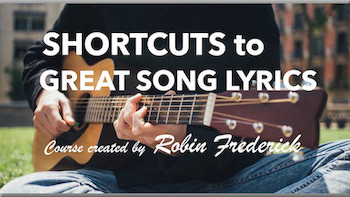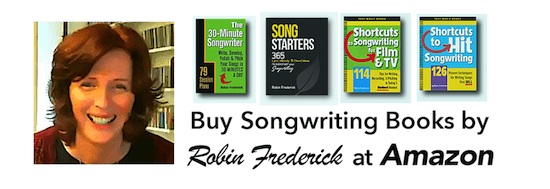WHY THIS SONG?
Not only is this song a huge worldwide hit but it’s also a great example of solid song craft that combines a well-written lyric with a catchy melody and cool dance club groove.
But wait, there’s more! This track features a smooth blend of successful old and new music styles. If you crave that ’70s vibe, you’ll love the Disco-happiness of this tune with its Funk bass and soaring strings mixed with today’s tight, punchy drum loops.
“FLOWERS” – Miley Cyrus
Songwriters: Gregory Hein / Michael Pollack / Miley Ray Cyrus
TECHNIQUES TO HEAR AND TRY
• Choose a lyric theme with broad appeal.
• Use a list of examples to express intention and emotion.
• Underscore the singer’s feelings with melody and groove.
LISTEN TO THE SONG. READ THE LYRICS.
Watch the lyric video on YouTube.
Read the lyric here.
GENRE/STYLE (Pop, Pop/Dance)
(What is a genre? Watch this video.)
This blockbuster, international Pop hit is currently topping Billboard’s Hot 100 music chart and headed for a billion listens on Spotify. It has become the number one Pop song in almost all European and Asian countries, as well as the U.S. and U.K.
While many current U.S. Pop hits are more rhythmically complex than this song, the very hummable melody, tightly focused lyric, and straight-forward Dance groove have given it enormous global appeal.
SONG STRUCTURE
The song structure is similar to many Dance/Pop hits. It has a 4-line verse, a short pre-chorus, and then a well developed chorus, followed by a post-chorus with a repetitive lyric.
VERSE / PRE-CHORUS / CHORUS / POST CHORUS
VERSE / PRE-CHORUS / CHORUS / POST CHORUS
PRE-CHORUS / CHORUS (repeat payoff line)
POST-CHORUS TO END
FIRST LINES
- Verse 1: “We were good, we were gold…”
- Verse 2: “Paint my nails cherry red…”
- Pre-Chorus 1 & 2: “I didn’t want to leave you…”
- Chorus: “I can buy myself flowers…”
- Post-Chorus: “Can love me better, I can love me better, baby”
THE DEVELOPMENT PATH
A strong lyric will develop an idea, a story, or an emotional situation over the course of a song. This compact lyric packs a lot of information into a small amount of space.
Verse 1: In just four lines, you get a picture of the relationship history—it was great until it wasn’t.
Pre-Chorus 1: Here’s a great kick-off line into a chorus. “I started to cry but then I remembered…” What did she remember? The chorus! How can you not keep listening!
Chorus: Here’s what she does to solve the problem and why she feels okay about it now.
Verse 2: The singer is moving on, getting her mojo back, and she is able to forgive. A nice touch and good development.
That’s all there is, but it’s all you need. The rest is repetition.
LYRICS
CHOOSE A LYRIC THEME WITH WIDE APPEAL
This song theme first appeared during the feminist movement of the 1970s which focused attention on female empowerment. Lyrics like Helen Reddy’s “I Am Woman” and Gloria Gaynor’s “I Will Survive” barely existed prior to the 1970s. (Lesley Gore’s recording of “You Don’t Own Me” was one of the very few exceptions.)
Today, the theme continues to resonate with women, but it can be understood (and written) by both men and women. Here Miley Cyrus and her male co-writers cast it as a woman rediscovering her ability to heal herself and make a start on a new and fulfilling life.
GIVE A NEW TWIST TO A CLICHÉ
The chorus lyric of “Flowers” features a string of romantic clichés. This could be insanely boring! But by turning them around the songwriters gave them a new life.
I can buy myself flowers
Write my name in the sand
I can take myself dancing
And I can hold my own hand
While these fresh images are fun to imagine, the payoff line is still serious: I can love me better than you can. And the line that sets it up earlier in the chorus is also serious: [I can] Say things you don’t understand. These are the only lines in the chorus that are not clichés. In these two lines, the songwriters tell us why the singer acts and feels the way she does.
Find out more about using clichés in your lyrics.
USE A LIST TO SHOW US WHAT YOU MEAN
This chorus is an excellent example of a list lyric, in this case a list of actions that support the emotional message of the song: I can take care of myself better than you can. Here’s a list of the ways I will do that. Lists are an excellent way to keep your lyric focused while adding plenty of images and actions, creating a more compelling experience for listeners.
TRY IT NOW
You can use lists in a verse, chorus, or bridge. Look for an opportunity to use a list in one of your own songs.
MELODY
USE A PROVEN MELODY PATTERN
The melody in Verse 1 starts with a short repeated phrase (“We we good / We were gold”), followed by a longer line (“Kinda dream that can’t be sold”). Then all of that melody is repeated. This is an excellent melody structure for a verse. The amount of repetition and variation is just right for listeners. (If you’ve read my book Shortcuts to Hit Songwriting, you know about the power of “Do it. Do it again. Go away. Come back.”)
MOVE THE NOTE RANGE UP
A melody that climbs upward adds energy to a song as it moves from verse to chorus. In “Flowers,” the pre-chorus melody moves up one note higher than the highest note in the verse, giving it a light uplift.
The final phrase of the pre-chorus (“remembered I…”) walks up the scale to the highest note of that section. That note, the highest note, is actually the first note of the chorus. Clever songwriters! It delivers the listener to the beginning of the chorus with plenty of emotional punch. This is an old trick but it’s still effective.
UNDERSCORE THE SINGER’S EMOTION
Although the highest note range was reserved for the chorus, did you notice that there were no big leaps upward or attention-grabbing fireworks? Instead the melody projects the solid, steady-on feeling the singer wants to express. She’s confidently moving on with her life and the steady climb of the melody reinforces that idea.
TRY IT NOW
When writing your melody, keep the singer’s character and feelings in mind. Is the singer bursting out of a sad, dark world into the light of day? Or is the singer feeling the I-won’t-be-stopped determination to achieve a goal? The melody and groove that accompany each of those two emotions is likely to be different: A big leap into the chorus with lots of energy versus a steady, mid-tempo groove and gradual melody climb.
CHORDS – “Flowers” by Miley Cyrus
In the chord progression, we have another example of the blend of contemporary Pop with the musical stylings of the ’70s. For most of the verse and chorus the chord progression consists of four repeated chords:
|Am | Dm | G | C |
This is the chord style of today’s Pop hits. But the final line of the pre-chorus ends on an E7 chord, a change we don’t often hear in contemporary Pop. However, it was used a lot in the Disco tunes of yesteryear. The final line of the chorus does something similar, moving through an F chord to the E7 again, before resolving to the A minor and starting up the four-chord progression for the post chorus.
You’ll find the chord progression here.
WILL THIS SONG WORK FOR FILM & TV?
While it’s not a slam dunk, “this song”Flowers” by Miley Cyrus could possibly work for film and TV scenes. On one hand, the list of actions is specific and might conflict with what a character is actually doing onscreen, but I could see the song being used to fill in a character’s thoughts as she simply walks out of a bad relationship.
Film & TV songs are generally used to express a mood or emotion. The lyrics are filled with imagery that helps the listener feel what the character is feeling. But they can also be used to “speak” for a character when the character either won’t allow themselves to voice what they’re thinking or there’s no one else to say it to. That’s when a song like this one might work.



